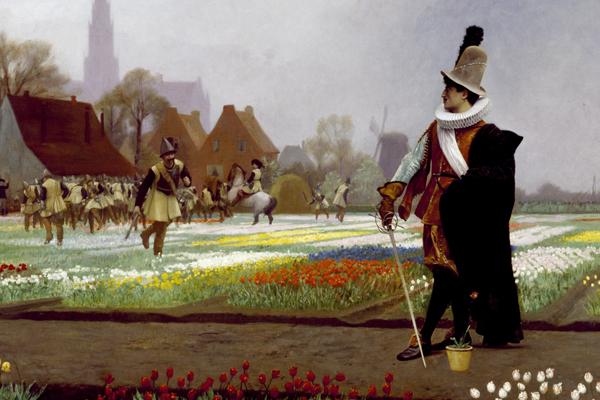
"The catastrophe of the Universal [Union Générale] had been one of those terrible shocks that make a whole city totter. Nothing had remained firmly standing. Other establishments had begun to give way; every day there were fresh collapses. One after another the banks went down, with the sudden crash of bits of walls left standing after a fire. In silent dismay folks listened to these repeated falls, and asked when the ruin would stop."
Émile Zola, L'Argent (1891)
During the tulipmania of the 1630s, as variegated tulips continued to demand outrageous prices, more growers were encouraged to enter a market already flooded with solid-colored flowers. In this detail from The Tulip Folly by Jean-Léon Gérôme, a broken tulip is defended by its aristocratic owner from government soldiers (the silhouette of Haarlem's St. Bavo church can be seen in the background). They are trampling the surrounding flower beds in an attempt to limit the supply of tulips and so keep prices from dropping even lower. The picture, too, was seen as the connoisseur defending beauty for its own sake. This is how it was perceived by Mary Jane Morgan, the widow of a wealthy shipping magnate, who was the first to own the picture. In 1886, a year after her death, it sold at auction for $6,000.
Painted in 1882, The Tulip Folly was a commentary as well on the crash that year of the Paris bourse (stock exchange). It was to be the worst financial crisis in France in the nineteenth century and inaugurated a recession that lasted until the end of the decade. As with the speculation in tulip bulbs two-and-a half centuries earlier, there was risk of default on contractual obligations in the time between the contract and delivery dates. As well as the inherent risk of these forward contracts, there also was counterparty risk, when the failure of one broker could threaten others. It was to control this risk that a common fund was established to mutually guarantee transactions by providing temporary credit to brokers who had no liquidity.
The crash of 1882 was precipitated by speculators in the stock of Union Générale, a fraudulent investment bank that had falsified its records and bid up its own shares. When it failed, there was uncertainty what the settlement price for its securities would be, whether it would be the price before or after the collapse of the market. When it was the latter, the common fund could not manage the default. Only a loan by the Bank of France averted the collapse of the exchange.
As the artist comments on the events of the day, so those events affected art itself. In 1882, Manet presented A Bar at the Folies-Bergère at the Paris Salon and Renoir The Luncheon of the Boating Party at the seventh Impressionist exhibition. But the primary dealer for the Impressionists had been financed by a partner in the Union Générale and no longer was able to buy Impressionist art or subsidize its artists. It was then, too, that Paul Gauguin, who had been a successful stockbroker complaining of reduced commissions, determined to devote himself to painting full-time—becoming, in less than two years, penniless in the process.
References: Money (L'Argent) (1902) translated by Ernest A. Vizetelly; Paul Gauguin: An Erotic Life (2001) by Nancy Mowll Mathews; "The Crash of 1882 and the Bailout of the Paris Bourse" (2007) by Eugene N. White, Cliometrica, 1, 115-144. The Tulip Folly is in the Walters Art Museum (Baltimore). Although The Tulip Folly was a gift to the museum, William Walters himself had secretly acquired a peach blossom porcelain vase at the Morgan auction for $18,000.